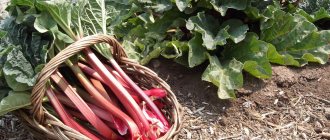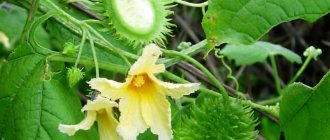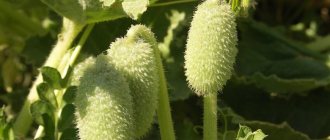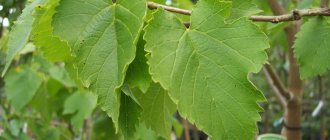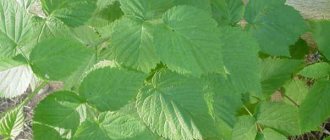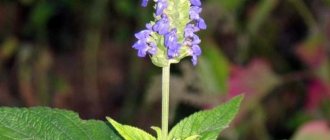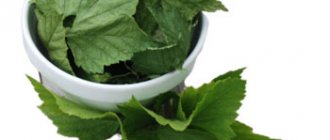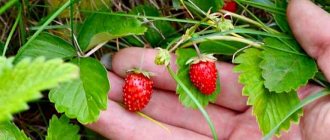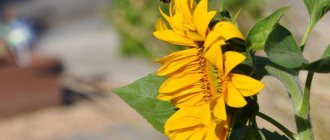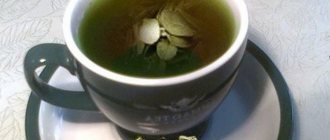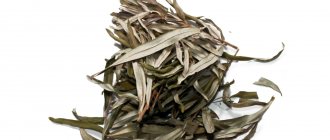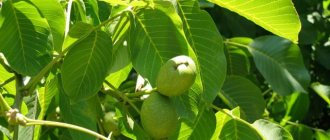What is rhubarb and how is it eaten?
Rhubarb is a perennial herb grown for its succulent, pinkish-red edible stems (petioles) with a tart, sour flavor.
It is native to Siberia and is now widespread in many regions of Europe and North America.
Rhubarb is rarely eaten raw. It is almost always cooked, sweetened with sugar, or used as one of the ingredients in recipes.
The petioles are the only edible part of the plant; its leaves are poisonous because they contain large amounts of a substance called oxalic acid. This compound is harmful if ingested in large quantities.
What rhubarb looks like - photo
general description
Botanically, rhubarb belongs to the family Polygonaceae, genus Rheum and is known by the scientific name Rheum rhabarbarum. The plant prefers cool climates.
Rhubarb stems are bright pink, but they also come in light pink and even pale green. The hue is not a sign of ripeness or sweetness. Rhubarb comes in different varieties, and all have almost the same taste and aroma.
Rhubarb - benefits
Rhubarb is a perennial plant that is used for culinary and medicinal purposes. Many people compare the taste of the plant stems to a sour apple. Based on rhubarb, you can prepare various dishes and drinks that will be beneficial for the body.
What are the benefits of rhubarb?
Due to the presence of a large amount of vitamins and organic acids, the plant is beneficial for the body, especially during the period of spring vitamin deficiency. Juicy petioles increase the body's protective functions against the negative influence of viruses and infections. Rhubarb has a positive effect on the cardiovascular system, which reduces the risk of heart attacks and other heart problems. The product contains polyphenols, which actively fight cancer cells. Rhubarb contains B vitamins and ascorbic acid.
Rhubarb root also has benefits. If you use it in small quantities, it will act as an astringent, and if in large quantities, it will act as a diuretic. This property helps to improve the functioning of the body. In folk medicine, the root is used to treat constipation and various intestinal diseases.
Separately, it is worth mentioning the benefits of rhubarb for weight loss. The calorie content of the product is at a fairly low level, so 100 g contains approximately 21 kcal. Only because of the sour taste, many people add sugar to the stems, which significantly increases the energy value. Rhubarb acids destroy intestinal bacteria and improve the functioning of the digestive system, which increases the speed of digestion of other foods. The plant has the ability to remove toxins and decay products, and it also normalizes the water balance in the body. Some sources claim that rhubarb helps reduce appetite. The benefits of tree rhubarb include a diuretic and laxative effect. Thanks to this, you will remove excess fluid, get rid of puffiness and lose several kilograms. Official medicine uses rhubarb to make medications, which, in general, are aimed at improving the functioning of the digestive system. In pharmacies you can find tablets that increase the body’s protective functions against such diseases: tuberculosis, anemia, psoriasis, and they also help in the treatment of various gall diseases.
It is worth considering that rhubarb can bring not only benefits, but also harm to the body. Given the oxalic acid content, people with diarrhea, liver and kidney problems should avoid consuming stems and leaves. Pregnant women should use this plant with caution. It is not recommended to consume rhubarb in large quantities, as it can lead to eating disorders.
The benefits of rhubarb jelly
Given the viscous consistency of the drink, it acts as an enveloping agent, which is especially useful for gastritis and stomach ulcers. Jelly also resists the development of dysbacteriosis. The prepared rhubarb drink retains all the beneficial properties of the plant, improves general condition, has a beneficial effect on digestion and on the functioning of the heart and liver. There are many different recipes for making jelly, which can be varied with berries and fruits.
Rhubarb jelly
Ingredients:
- starch – 45 g;
- rhubarb – 500 g;
- water – 1 l;
- sugar – 100 g.
Preparation
Take a saucepan and add chopped rhubarb, sugar and water. Bring to a boil, then remove from heat and cool. Drain the liquid and grind the rhubarb in a blender. Combine the resulting puree with the broth, put it on the stove and cook for 1 minute. The drink can be consumed both hot and cold.
WomanAdvice.ru>
How and where it grows
Rhubarb is one of the easiest plants to grow and can grow in one place for 10-15 years. It usually reproduces by dividing rhizomes.
A mature plant has stems 30 to 50 centimeters long and broad, heart-shaped, dark green leaves. It is these stems (petioles) that are used (after cutting off their upper leaf part) in cooking.
They are ready for harvest starting from the second year, when they reach sufficient thickness - from 2.5 to 5 cm.
Growing and caring for rhubarb
The plant does not require particularly careful care. Most often it is grown from seeds, and then the finished seedlings are planted in open ground. The optimal temperature for growth is +8…+12°C.
Seedlings are planted in a permanent place in the spring. First, make deep holes, pour a little humus and mineral fertilizers into them. The roots are placed in the prepared soil and sprinkled with earth on top. Additionally, you will need to sprinkle the soil with humus or peat. Water as needed.
Where to buy and how to choose
Fresh rhubarb stems can be purchased at markets in most parts of the country from April to July.
If you are growing it in your garden, pluck the petiole by grasping it at the base while pulling and twisting it. Immediately separate the stem from the leaf part. Rhubarb greens contain oxalic acid, as well as poisonous glycosides.
Read about growing rhubarb in your summer cottage in this publication from rblogs.ru.
When shopping at the market, look for fresh, firm, crisp, bright red stems. Do not take dull, flaccid petioles with spots on the surface.
Rhubarb: harm and contraindications
Despite the abundance of beneficial substances, rhubarb can be harmful to health. This can be avoided if you do not use the product if you have the following contraindications:
- Individual intolerance.
- Pregnancy.
- Lactation period.
- Hemorrhoids at the bleeding stage.
- Chronic pathologies of the gastrointestinal tract.
- Rheumatism.
- Gout.
- Kidney stone disease.
- High acidity of gastric juice.
- Indigestion.
The real benefits of rhubarb are noted only if it is consumed in limited quantities in the absence of contraindications. Otherwise, it can cause painful symptoms that worsen a person’s overall health.
Article rating
Use in cooking and recipes
Rhubarb recipes most often require first chopping and then stewing, frying, or otherwise processing the chopped stalks at high temperature. Typically a small amount of water and sugar or alternative sweeteners are added. This sweetens the sour petioles. Pairing rhubarb with another naturally sweet fruit helps cut down on added sugar.
To prepare the rhubarb dish:
- Trim the ends of the stems with a paring knife.
- Wash them in cold running water, gently rubbing the surface with your fingers.
- Cut the rhubarb into pieces 1-2 cm in size. If the petioles are too mature, remove the hard fibers (threads).
Here are some useful tips on what rhubarb goes with:
- stems are used for making sauces, canned food, jellies, preserves, jams, syrups, sorbets, compotes, kvass, juices;
- rhubarb is best known for its delicious pie recipes;
- pies, pancakes, pancakes, charlottes, muffins, strudels are prepared with it;
- Rhubarb goes great with strawberries. Pie with these two ingredients is the most popular baking recipe, but there are many other options, such as donuts, brownies and cakes;
- it is used to make homemade wine.
Rhubarb and strawberries are a popular combination in baking recipes.
Rhubarb and cheese salad recipe
This is a delicious and simple recipe for making a salad of rhubarb, walnuts and Adyghe cheese. It turns out original and piquant.
What you will need:
- 300 g rhubarb petioles, cut into 2 cm pieces;
- ¼ cup honey;
- ½ tbsp. walnuts;
- 2 tbsp. l. olive oil;
- 2 tbsp. l. balsamic vinegar (preferably white);
- coarse salt and ground pepper to taste;
- 4 bunches of arugula (about 400 g in total), tough ends removed;
- ½ cup Adyghe cheese, crumble.
Cooking method:
- Preheat the oven to 200 degrees.
- Place rhubarb mixed with honey on a baking sheet. Roast on the top rack for up to 5 minutes to soften slightly. Let cool.
- On another baking sheet, toast the walnuts on the lower rack until fragrant, 5 minutes. Cool, then grind in a food processor.
- In a large bowl, combine oil and vinegar and season with salt and pepper.
- Add arugula, honeyed rhubarb, walnuts and sprinkle with cheese.
Delicious pie with rhubarb and strawberries
This is a classic American rhubarb pie recipe topped with a beautiful wicker lattice.
Ingredients:
- 6-8 tablespoons flour;
- 2 cups sugar;
- 1 tablespoon butter, cut into small pieces;
- 4 tbsp. chopped rhubarb;
- 2 tbsp. strawberries, cut into pieces.
Cooking instructions:
- Preheat the oven to 200ºC.
- Mix flour and sugar in a large bowl. Add rhubarb and stir.
- Divide the dough into 2 parts, roll out one of them to a thickness of 0.7-1 cm and place in a round baking dish.
- Place rhubarb and strawberries on top and add butter.
- Roll out the second part of the dough and cut into strips, decorate the top of the pie, intertwining them with a lattice. Trim the edges and crimp the top and bottom of the dough together.
- Place the pie on a baking sheet and bake for 10 minutes.
- Reduce heat to 170ºC and bake for a further 30-50 minutes until the filling begins to bubble. Cover the edges with foil if the cake is baking too quickly.
Useful properties of rhubarb
Residents of the CIS still significantly underestimate rhubarb. Most people know about the culinary uses of this plant, but few know about the healing properties of rhubarb. Let's consider them in more detail.
The healing properties of rhubarb are used for ailments:
- nourishes brain neurons and prevents their hypoxia;
- cardiovascular diseases (coronary heart disease, pre-infarction condition, pre-stroke condition), rhubarb inhibits heart attacks;
- strengthening bone tissue, healing the mucous membrane;
- prevention of hypertension;
- improves vision and promotes resorption of eyesores;
- protection against spring vitamin deficiency, as an antiscorbutic agent;
- restoring skin regeneration, for psoriasis, after burns;
- improves appetite (including in children);
- as an antispasmodic for pain in the liver, kidneys, gall bladder, spleen, uterus;
- to prevent anemia;
- for the liver, thanks to its excellent choleretic agents, for hepatitis;
- in the prevention and treatment of tuberculosis;
- tachycardia;
- increases the body's resistance to many infections (ARVI, influenza, pneumonia);
- inflammation of the stomach, intestines, dispersion, intestinal atony, flatulence, constipation;
- with damage to the bladder;
- as a cleansing and laxative for excess weight and weight loss (in small doses it has a strengthening effect, in large doses it has a laxative effect).
The vitamins and minerals contained in the leaves and roots are in high concentration, therefore they have a strong effect on the body, replenishing the lack of substances important for all life processes:
- Calcium - strengthens bones and joints, improves heart function.
- Potassium - normalizes blood pressure (with hypertension), strengthens the heart muscle and blood vessels, relieves swelling (removes water from the body).
- Sodium is responsible for the functioning of the kidneys, regulates the mineral composition of body fluids (blood, lymph, etc.), retains water in the body (useful for increased physical activity).
- Iron regulates the chemical composition of the body and affects all processes.
- Selenium has a protective function in the body, strengthens the heart and muscles, prevents the development of cancer (especially breast cancer in women), and strengthens joints.
- Magnesium - regulates energy processes inside the body, provides cells and tissues with nutrients, regulates metabolic processes, increases the reproductive abilities of the body, strengthens the nervous and immune systems.
- Phosphorus - increases the digestibility and decomposition of sugars, strengthens bones and teeth, is necessary for muscle function, and strengthens the nervous system.
- Vitamin A (carotenes) - regulates and normalizes metabolic processes, has a positive effect on the organs of vision, strengthens bones and skeleton, increases immunity (how to take echinacea tincture), increases the regenerative abilities of the body.
- B vitamins regulate all processes in the body, participate in the formation and construction of new cells, strengthen blood vessels and nerve cells, and give the body energy and strength.
- Vitamin C is a natural antioxidant (fights cancer and radiation exposure), prevents the aging process, dissolves fat cells (herbs for weight loss that burn fat), removes toxins and waste.
- Vitamin E (tocopherols) - strengthens the muscular system (participates in the construction of muscles), regulates the monthly cycle in women (prevents premature pregnancy), increases immunity (recipe for strengthening) in all organs and tissues.
- Vitamin K - increases blood clotting, regulates blood processes, strengthens the cardiovascular system.
In large quantities, medicines from the root can be poisonous. It is only safe to consume the petioles in the form of various culinary dishes. Rhubarb is included in the ready-made pharmaceutical medicines “Holaflux” (as a choleretic agent) and “Chrysarobin” (for the treatment of psoriasis).
Chemical composition and calorie content
Nutritional value per 100 g of fresh rhubarb (Rheum rhabarbarum):
- Calories: 21 cal.
- Carbohydrates: 4.54 g
- Dietary fiber: 1.8 g
- Fat: 0.20 g
- Protein: 0.90 g
| Vitamins and minerals | Quantity | % of daily value |
| Folates | 7 mcg | 2 |
| Niacin | 0.300 mg | 2 |
| Pantothenic acid | 0.085 mg | 1,5 |
| Pyridoxine | 0,024 | 2 |
| Riboflavin | 0,030 | 2 |
| Thiamine | 0,020 | 2 |
| Vitamin A | 102 ME | 3,2 |
| Vitamin C | 8 mg | 12 |
| Vitamin E | 0.27 mg | 2 |
| Vitamin K | 29.3 mcg | 24 |
| Sodium | 4 mg | 0,5 |
| Potassium | 288 mg | 24 |
| Calcium | 86 mg | 8,5 |
| Copper | 0.021 mg | 2 |
| Iron | 0.22 mg | 3 |
| Magnesium | 12 mg | 3 |
| Manganese | 0.196 mg | 8,5 |
| Phosphorus | 14 mg | 2 |
| Selenium | 1.1 mcg | 2 |
| Zinc | 0.10 mg | 1 |
| Beta carotene | 61 mcg | — |
| Lutein-zeaxanthin | 170 mcg | — |
The calorie content of 100 g of fresh rhubarb petioles is only 21 calories. This vegetable contains vital phytonutrients: dietary fiber, polyphenolic antioxidants, minerals and vitamins. It has no saturated fat or cholesterol.
The stems contain several B vitamins: folate, riboflavin, niacin, vitamin B-6 (pyridoxine), thiamine and pantothenic acid.
Red petioles contain more vitamin A than green varieties. They also contain small amounts of polyphenolic flavonoid compounds such as beta-carotene, zeaxanthin and lutein. In the human body, they are converted into vitamin A, a powerful natural antioxidant that maintains the integrity of the skin and mucous membranes. It is also important for healthy vision. Natural foods rich in vitamin A protect against lung and oral cancer.
Like other green vegetables (kale, spinach, etc.), rhubarb stems also provide adequate amounts of vitamin K (29.3 mcg per 100 g, or about 24% of daily recommended intake). It plays an important role in bone health by helping to strengthen them.
Adequate levels of vitamin K in the diet help limit damage to neurons in the brain, and thus help in the prevention and treatment of Alzheimer's disease.
The petioles also contain beneficial minerals such as iron, copper, calcium, potassium and phosphorus. However, most of these minerals are not absorbed by the body because they are converted to an insoluble form by oxalic acid, which is then excreted from the body.
Rhubarb contains more calcium than the same amount of milk, but in a form that the body cannot easily absorb.
Composition of rhubarb
The benefits and harms of rhubarb directly depend on its composition. It includes a lot of nutrients that the human body may need.
Important! The above-ground and underground parts of the natural product are distinguished by their rich composition.
Rhubarb petioles boast the presence of the following components:
- Pectins.
- Starch.
- Cellulose.
- Sucrose.
- Vitamin K
- Ascorbic acid.
- Calcium.
- Silicon.
- Potassium.
- Oxalic, succinic and malic acid.
Each of the listed substances has a beneficial effect on human health, so it is imperative to take care of enriching the body with them.
Rhubarb roots also have a unique composition. They contain:
- Tannins.
- Anthraglycosides.
- Resins.
- Pectins.
Due to its rich composition, rhubarb should be included in your diet in limited quantities.
Calorie content of rhubarb
Rhubarb is a low-calorie product. Its 100 g contains no more than 13 calories. Given this feature, you can safely consume plant-based treats while following a strict diet.
Benefits and harm to the body
The average amount of rhubarb eaten daily, from which the benefits will exceed and neutralize its harm, is 2/3 cup. In large doses, it can be dangerous to health; see rblogs.ru for more details.
Beneficial features
- Relieves constipation. It has a laxative effect due to its tannin content and large amounts of dietary fiber.
- Strengthens bones. Rhubarb contains a good dose of vitamin K, which improves bone metabolism and helps prevent fractures and osteoporosis.
- Useful for weight loss. Rhubarb lowers bad cholesterol levels, and since it is a low-calorie food, it fits well into a weight loss diet.
- Helps improve vision. Rhubarb contains lutein and vitamin C, both of which work well for eye health.
- Preserves the beauty of the skin. Vitamin A in this vegetable neutralizes free radicals and slows down aging and the appearance of wrinkles.
- Supports brain health. Vitamin K in rhubarb limits neuronal damage to the brain and thereby prevents Alzheimer's disease.
- Beneficial for the female body. It contains phytoestrogens, which relieve symptoms of PMS (premenstrual symptoms), and in the case of menopause, relieve hot flashes, reduce sweating, fatigue and sexual problems, improve sleep, mood, and quality of life.
Rhubarb and traditional medicine
The unique beneficial properties and contraindications of rhubarb allow it to be actively used in the preparation of folk remedies for the treatment of certain diseases.
Fresh rhubarb is used in the preparation of the following healing compounds:
- Tincture. Intended to improve intestinal function.
- Powder. Helps cope with diarrhea.
- Juice. An effective remedy for solving the problem of vitamin deficiency.
- Infusion. Recommended for anemia.
- Compress. Allows you to replace an antiseptic if you don’t have one on hand.
Note! The benefits of rhubarb are noted when consumed in any form. The greatest care in this case is provided to the cardiovascular system.
Precautionary measures
Rhubarb, like all foods, can cause some side effects. These primarily include gastrointestinal problems.
Under no circumstances should the leaves be eaten. Due to the presence of oxalic acid, they cause many health problems. For example, these are toxic symptoms such as burning in the eyes, throat and mouth, breathing problems and swelling of the skin.
Pregnant women or patients with kidney or liver disease should consult a doctor before using rhubarb for medicinal purposes.
On a more serious note, consuming rhubarb inappropriately can lead to kidney failure, coma, convulsions, and even death.
People suffering from kidney disease, gout and rheumatoid arthritis should avoid this food.
Rhubarb sometimes causes abdominal pain, severe uterine contractions and diarrhea. Long-term use leads to loss of bone mass and potassium, muscle weakness.
It is completely unsafe for children. In addition, it worsens an existing condition of diarrhea or constipation. It is also contraindicated in patients with kidney stones.
Do not consume rhubarb in large doses as its safety is not definitively known. When taken in large quantities, rhubarb interacted with cardiac glycosides (digoxin) and decreased absorption of orally administered drugs.
The leaf blades (but not the stems) of rhubarb contain enough oxalic acid to cause poisoning. Acute renal failure has been associated with long-term use of anthraquinone.
How to properly collect rhubarb?
When harvesting, the stems are carefully pulled or cut from the plant, and the poisonous leaves are removed immediately. While some picky eaters shy away from rhubarb, many gardeners choose it for its beautiful addition to the landscape. This is because it has large green stems and colorful stems.
It is better not to harvest in the first year. To get a good harvest you need to wait two or three years.
Wondering when to harvest rhubarb? It is best to wait at least two years. Then collecting the stems will not damage the plant, but rather strengthen it and allow it to become more productive.
The rhubarb harvesting season lasts from approximately April to June. Typically, plants can be harvested over a four-week period in the third year, or about 8 to 10 weeks in subsequent years.
When should you not choose rhubarb, and can it be collected in the fall? Ideally, it is best to stop harvesting by mid-June. Harvesting too late reduces the yield and quality of the next year's crop.
How to properly freeze rhubarb?
You will need to trim off all the leaves first as they are slightly toxic. We don't need leaves at all.
Trim the ends and rinse the rhubarb stems under cold water to remove all traces of dirt. Dry them gently with a towel, then cut them into 2 - 2.5 cm pieces.
Place the chopped rhubarb on a baking sheet or any other container that will fit in the freezer. Even better, cover the baking sheet with parchment paper.
Leave the stems in the freezer for at least 4 hours, if not overnight. Then you can put them into bags.
Frozen rhubarb retains virtually all of its nutrients for up to 1 year.
Frozen stems can be used in a variety of ways. But they are best suited for baking pies and muffins. Although, of course, smoothies are also prepared with them, especially in combination with sweeter fruits, because rhubarb itself is very tart.
Frozen rhubarb is different from fresh. It softens a lot and releases some liquid after defrosting. In addition, its aroma is slightly lost.
Pests and diseases of rhubarb
Rhubarb diseases
Not so long ago, it was believed that rhubarb was invulnerable to both infections and harmful insects, but with poor care, even this plant can get sick. Most often, rhubarb is affected by ramularia, ascochyta blight, powdery mildew and rust.
Ramularia: Signs of this fungal disease appear as red-brown spots with a dark red border on rhubarb leaves. As the disease progresses, the spots increase in size and merge with each other, and their middle gradually turns pale. In dry weather, the tissue inside the stains cracks and falls out, and in humid weather, the stains become covered with a white or silver-gray powdery coating. The disease progresses in dense plantings, especially in warm, humid weather. For preventive purposes, it is necessary to remove plant debris from the area in the fall, after which the surface should be treated with one percent Bordeaux mixture or any other copper-containing preparation.
Powdery mildew - this disease can be recognized by a whitish, loose coating on the leaves of the plant, which over time becomes dense and brown. The disease appears in early summer. As a result, the affected areas stop growing, turn black and die, the inflorescences do not form ovaries, and the plants lose winter hardiness. Powdery mildew must be combated using the same methods as ramulariasis. The best drugs for this infection are the biofungicides Alirin-B, Gamair, Planriz and the like.
Rust is also a fungal infection that forms pustules on rhubarb leaves, from which, when cracked, a rust-colored powder - fungal spores - spills out. The affected plant's metabolism is disrupted and growth is reduced. Diseased leaves must be removed and the plant treated with Topaz 2-3 times with an interval of 10 days.
Ascochyta blight forms large brick-ocher spots of irregular elongated shape on the leaves. The tissues in these places crack, dry out and crumble. The infection can be destroyed by treating rhubarb with one percent Bordeaux mixture.
- Valdai cucumber variety
However, since plants have the ability to accumulate poisons and toxins in their stems, leaves, petioles and roots, try to refrain from using fungicidal drugs. It is better to use mullein infusion against fungal diseases. It is prepared like this: pour a third of a bucket of fresh cow dung with cold water and, stirring from time to time, leave for three days. Then the composition is filtered through thick cloth, diluted with water in a ratio of 1:10 and the rhubarb is treated with this composition the next evening after sunset.
Rhubarb pests
Among the pests that are dangerous for rhubarb are cutworm caterpillars, onion nematodes and rhubarb weevil.
Cutworm eggs overwinter near rhubarb bushes; in the spring, dirty white or yellow caterpillars up to 45 mm long crawl out of them, penetrate into the stem and petioles and feed on their pulp. The damaged tissues dry out, and the caterpillars crawl into the still undamaged petioles. To get rid of these pests, you need to immediately cut out damaged stems and petioles, and also destroy weeds near which cutworms lay eggs.
The rhubarb weevil is a bug up to 6 mm long, the elytra of which are covered with light gray and brown scales. Weevils feed on rhubarb leaves, and females lay eggs in leaf petioles. The emerging legless, dirty yellow larvae live on the leaves, feed on them and pupate in them. You can repel weevils by treating rhubarb with a solution of 5 g of potassium permanganate in 10 liters of water.
Onion nematodes are microscopic worms that live in the stems, petioles and leaves of rhubarb. They cause the tissues of the plant to soften and swell, causing the plant to die. Effective measures to combat nematodes have not yet been invented, so affected specimens should be removed and burned, and nothing should be grown in the area where these pests are found for at least two years.
